CoinW Research Institute: Magic Eden in-depth research report
ملخص
Magic Eden is a multi-chain NFT تجارة market created by a Chinese team. It has been established on the Solana chain since 2021 and has rapidly expanded to support Ethereum (ETH), Polygon, BASE, and Bitcoin (BTC) ecosystems. Despite the recession in the NFT market, Magic Eden has successfully captured a major market share of the Solana chain with its rapid product iteration and rich functional design.
The core functions of the platform include NFT trading market, multi-chain support, project incubator (Launchpad), pledge and revenue rewards, aggregate market, data analysis and rankings, wallet integration, community governance (DAO) and API integration. In addition, Magic Eden also provides users with limited-time discounts, rarity rating system, on-chain identity authentication, member passes, batch transactions and custom package features. Through these value-added services and detailed data support,
Magic Eden lowers the usage threshold for new users, optimizes the trading experience, and improves the user stickiness of the platform.
Magic Edens main sources of income include transaction fees and service fees for Launchpad projects. Although no tokens have been issued, the platform has launched a points system, and users can accumulate points through platform activities for future airdrops. At the end of 2024, the platform also launched a test token $TestME, which aims to test the issuance process of the future official token $ME.
In the context of the overall downturn in the NFT market, Magic Eden remains competitive, and its growth potential mainly comes from its support for the BTC ecosystem, which is still a blue ocean market. If NFTs on the BTC chain become popular, Magic Eden is expected to have a broader development space in the future and further consolidate its leading position in the multi-chain NFT trading market.
مقدمة المشروع
Magic Eden is a multi-chain NFT trading market with Chinese background. In the state of extreme shrinkage of the NFT track, it has gradually occupied most of the market share by relying on its own rapid iteration engineering advantages. Seeing the development of the Solana public chain, Magic Eden was first created on the Solana chain in 2021. Subsequently, Magic Eden supported the ETH ecosystem, Polygon ecosystem, BASE ecosystem and BTC ecosystem.
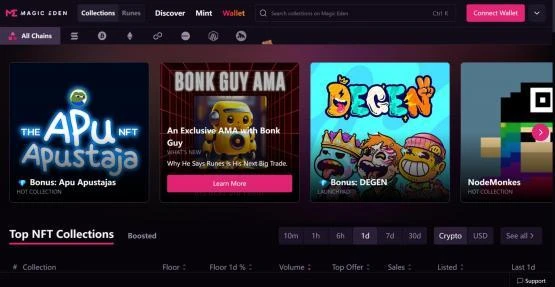
Figure 1 Magic Eden
Data source: Magic Eden
1.Magic Eden Platform Features
Magic Eden is now more than just an NFT trading market. Due to the expansion of its business, Magic Eden currently has the following functions:
-
نفت سوقplace: Provides a user-friendly interface for browsing, buying, selling, and auctioning NFTs. Users can filter by price, rarity, popularity, etc.
-
Multi-chain support: Not only supports the Solana ecosystem, but also extends to the Ethereum and Bitcoin ecosystems, allowing users to create and trade NFTs on different chains.
-
Launchpad: This is a platform for incubating and issuing new NFT projects. Through Launchpad, project owners can get support to issue and promote NFTs more easily, and users have the opportunity to purchase in advance.
-
Staking and Rewards: Users can stake their NFTs to earn rewards (such as tokens or other NFTs), thereby increasing the value of their NFT holdings.
-
Aggregate Market: This function can aggregate the transaction lists of other NFT platforms to help users find the transaction prices and supplies of major NFT markets on one platform.
-
Analysis tools and rankings: Provide market analysis, transaction trends and NFT collection rankings to help users understand popular NFT projects and market trends.
-
Wallet integration: compatible with multiple تشفير wallets, making it convenient for users to recharge, withdraw and trade.
-
DAO and Community: Magic Eden has a community governance and discussion platform where users can participate in DAO voting and make suggestions on platform development.
-
API integration: Provide APIs to developers for integration into other applications to enhance the platform ecosystem.
2. Magic Eden unique features
In the most important NFT transactions, Magic Eden has expanded more functions to facilitate user operations:
-
Limited-time offers: Magic Eden will occasionally launch limited-time offers, where users can enjoy discounts or special prices when purchasing specific NFTs within a specified time. This limited-time offer increases trading activity and gives users the opportunity to obtain high-quality NFTs at a lower cost.
-
Dynamic rarity rating system: To help users quickly assess the scarcity of NFTs, Magic Eden has designed a dynamic rarity rating system. When browsing NFTs, users can view their rarity level or score in real time, which allows them to judge the rarity of a particular NFT in the entire series. This is particularly helpful in determining whether it is worth bidding high or buying directly.
-
On-chain identity and authentication: To improve transaction security, Magic Eden allows project owners to authenticate their NFT series on the chain to ensure their authenticity. The Verified or Not Verified label will be displayed on the platform, and users can rest assured to purchase certified genuine NFTs to avoid purchasing counterfeit assets.
-
Magic Eden Pass member-exclusive function: Magic Eden has issued a membership pass NFT (Magic Eden Pass), and holders can enjoy a series of exclusive rights, such as priority purchase rights, transaction discounts, limited collection airdrops, etc. This membership mechanism encourages users to be active on the platform for a long time.
-
Batch trading and instant transaction: Magic Eden supports the function of buying and selling NFTs in batches, allowing users to trade multiple NFTs at one time, which is suitable for large collectors or investors. At the same time, the platform introduces the instant transaction function, which allows users to immediately sell their NFTs at the lowest price provided by the platform and quickly complete the cash.
-
Custom NFT Collection Combinations: Magic Eden provides a unique custom collection combination feature, where users or project owners can create and sell bundles containing multiple NFTs, grouping certain related NFTs together and selling them at a higher price. This approach attracts collectors and users who are interested in specific topics.
-
NFT staking and revenue sharing: Users can stake their NFTs on the platform to earn revenue or participate in revenue sharing projects. For example, staking game NFTs can earn in-game rewards or participate in profit sharing. This feature increases the investment attributes of NFTs, allowing users to generate revenue while holding them.
-
Minting window: Magic Eden provides a unique minting window feature for some popular projects, which is to open the minting (generation) of new NFTs in a specific short period of time. This short-term limited minting method gives users the opportunity to obtain NFTs at the original price instead of buying them at a premium in the secondary market.
-
Personalized recommendations based on on-chain and off-chain data aggregation: Magic Eden uses on-chain and off-chain data (such as community activity and holder data of projects) to provide users with personalized NFT recommendations. Users will not only see the NFTs they are interested in, but also get suggestions, explore new projects or trends, and improve the efficiency of discovering potential NFTs.
3. Magic Eden Revenue
Like other NFT trading markets, Magic Edens main income comes from two aspects: one is the transaction fees of platform users, and the other is the service fees brought by the launch projects.
-
Transaction Fee: Magic Eden charges a transaction fee for each NFT transaction, usually 2% of the transaction amount. This is its main source of income.
-
Launchpad charges: Magic Edens Launchpad platform helps new projects issue and promote NFTs. Project parties using Launchpad need to pay a certain service fee, or receive a portion of the issuance amount in return. Launchpad provides project parties with platform exposure, promotion support, on-chain certification and other resources, so the charges are relatively high.
The Rise of Magic Eden
Magic Eden was launched in September 2021. On one day in May 2022, the daily transaction volume exceeded that of Opensea, which was valued at 13 billion US dollars at the time. What made a new platform that was established less than a year ago surpass the leader that was established five years ago in less than a year? This is inseparable from the prosperity of the Solana ecosystem and the NFT market at the time. But more importantly, Magic Edens special product design.
1. Detailed user guidance
Magic Eden was born in a bull market, when a large number of new users entered the market. They had never traded in cryptocurrencies or used centralized wallets. They started playing with NFTs. This was quite difficult for novices to get started. Therefore, Magic Eden مرشدd users step by step from the beginning, providing detailed introductory guidance and a full set of video explanations from wallet creation to the first purchase of NFTs. This greatly reduced the difficulty for users to enter the market.

Figure 2 Magic Eden Help Center Article
Source: Magic Eden
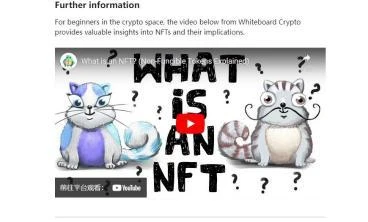
Figure 3. What is an NFT?
Source: Magic Eden
2. Detailed data of Magic Eden NFT market
In addition to providing good user guidance, Magic Edens advantage is the detailed data provided by the platform. I remember when I first started playing on OpenSea, the basis for judging purchases was often whether the NFT looked good or not. Since everyones aesthetic level is different, the path to success cannot be copied. After MagicEden entered the market, it set up functions such as popular NFT series, release calendar, and data statistics dashboard. Players can directly track and study the projects they are interested in on the platform, make trading decisions and asset allocation, and achieve a closed loop. There is no need to go to other platforms to see the data of each NFT series. Users have entered the era of trading data from trading aesthetics.
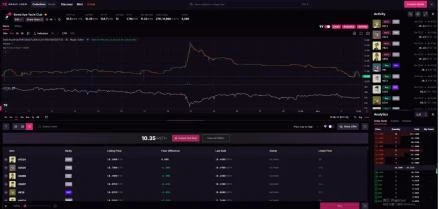
Figure 4 MagicEden trading panel
Source: Magic Eden
This is the advantage of the teams background. The team members come from big web2 companies: Google, meta, uber, etc. They deeply understand the importance of product design to the project and have polished a fairly mature project from the beginning.
Track Analysis
The NFT track emerged in 2021. With the outbreak of Bored Ape, the track reached its most prosperous period. However , with the advent of the bear market, the decline of NFT was even more tragic than that of FT. According to the data from the NFTScan website :

Figure 5 NFT market data
Data source: NFTscan
At present, a total of 2.1 billion NFTs have been issued with a market value of 24 billion US dollars, but the 24-hour trading volume is less than 10 million US dollars. Most NFTs are in a state of having a price but no market. There is no doubt that it is still a deep bear period for NFTs. The trading volume of all NFTs combined is not as good as the trading volume of a popular meme coin in one day. And due to the limitations of NFTs themselves, they cannot be directly listed on centralized exchanges. This not only makes NFTs lose more endorsements, but also makes NFTs lose a lot of liquidity. Centralized exchanges can only create another NFT market. But often there are very few users who pay attention to such markets. At present, there is basically no liquidity. But the blockchain itself is constantly developing in the direction of decentralization and on-chain development. At present, the number of active people on the chain is only about one-tenth of that of centralized exchanges, and there is still a lot of growth opportunities. And the NFT track will also explode with the paradigm shift from centralized exchanges to decentralized exchanges. According to this reasoning, the NFT track will explode in the late bull market. This leads to the diversion of funds and the decline of token prices on CEX. Therefore, paying attention to the development of the NFT track can help you better grasp the rhythm of the market and adjust your positions.
At present, the most important application of the NFT track is still the NFT market. Since the birth of opensea in 2017, the NFT market has experienced more than 7 years of development. At present, there are 238 trading markets in the whole chain.
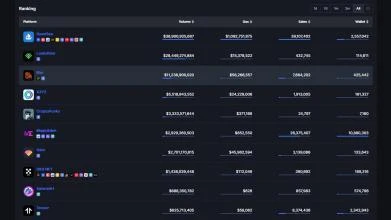
Figure 6 NFT market data
Data source: NFTscan
The top ten NFT markets (as of October 31, 2024) include four markets that have issued tokens and eight markets that involve the Ethereum chain. Here are a few representative markets for comparison:
Opensea, Blur, MagicEden, OKX NFT. Opensea ranks first in both historical and recent transaction volumes. Except for Opensea, the remaining three markets have reached their current overall transaction volumes because of token incentives (NFTs are obtained by increasing transaction volume). Although MagicEden also has a points mechanism, it is different from directly issuing tokens for incentives. From this perspective, MagicEden is actually the second in the market.
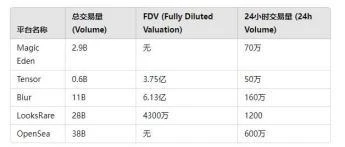
Figure 7 NFT market data
Data source: NFTscan
From the comparison of trading volume, we can see that MagicEden is in the same echelon as tensor, and their 24-hour trading volume is at the same level.
In terms of products, MagicEdens product power is obviously stronger. MagicEden has launched its own wallet. In the blockchain era, due to the characteristics of wallet links, most users have no loyalty to the project. Because the migration cost is too low. Therefore, many projects have launched loyalty, hoping that users can stay on their platforms, especially various NFT platforms. If your orders are all on their exchanges, then you will have 100% loyalty and will enjoy the best rates and rewards. But the wallet is obviously a higher-level strategy, because using the projects wallet, you will inevitably get used to using their exchanges.
رمز مميز النموذج الاقتصادي
There is currently no token economic model
MagicEden has its own points system, which is also a guarantee for future airdrops. There is a chance to accumulate diamonds in any activity within the platform, but no details have been given yet.
However, the project recently launched a test token $TestME, which can be claimed from 11 a.m. on October 29 to 5 p.m. on October 31, Pacific Standard Time, after which the remaining supply will be destroyed.
The official launch of test tokens has two purposes:
1. Help users get familiar with the process of receiving tokens.
2. Help identify and resolve any potential issues before the official $ME token is released.
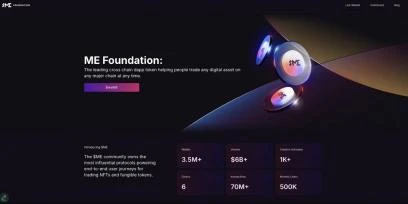
Figure 8: Interface for collecting test tokens $TestME
Source: Magic Eden
This is the interface for claiming test tokens. The claim period has ended. A total of 250,000 wallets participated in the claim, and the popularity of claiming is also very high. To claim test tokens, you need to download the Magic Eden wallet and meet the following conditions:
1. A wallet that has recently used the Magic Eden platform, or has purchased, sold, or accepted bids in the past 6 months and has at least one transaction of more than $100
2. Randomly select users who have recently traded tokens on the chain.
Team Background
CTO: Sidney Zhang
In 2013, Sidney founded his first cryptocurrency company, starting with a Bitcoin developer API. In 2015, he joined Uber as one of the founding engineers of Uber Eats, working on Uber Eats from scratch until it took off. Sidney then worked at Uber Advanced
Technologies Group for several years, working on autonomous driving production modeling and research, focusing on computer vision and prediction. Finally, he joined Facebooks AI team before co-founding Magic Eden.
CEO: Jack Lu
Jack got involved in the cryptocurrency space in 2013 when he began hacking Bitcoin wallet applications. Prior to co-founding Magic Eden, Jack worked at a cryptocurrency exchange, as a product manager at Google, and as a consultant at the Boston Consulting Group.
COO: ZhuoxunYin
Zhuoxun has been working in the cryptocurrency industry full-time since 2017, where he was the second employee at dYdX and a senior product manager at Coinbase. Prior to entering the cryptocurrency industry, he worked in strategy at early-stage companies and consulted for corporate clients at Bain Company earlier in his career.
CE锛歓huojie Zhou
Rex started his cryptocurrency journey around 2014, working in cryptocurrency mining. He was previously a member of Uber,
An early engineer at Checkr, he most recently worked as a senior engineer at Facebook AI on PyTorch Dev Infra before co-founding Magic Eden. He is passionate about the open source developer community and has created Flagr, OpenMock, Open Privacy Vault, and DSRHub. Rex is also one of the Kong API Gateway community champions.
Investment and Financing Background
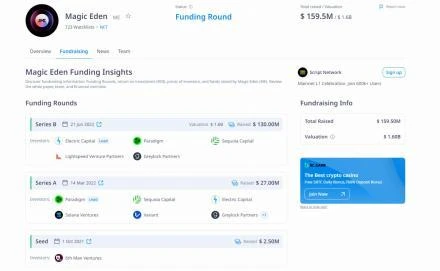
Figure 9: Magic Eden financing details
Data source: CryptoRank
Financing details:
Seed round: On October 1, 2021, the investment institution 6th Man Ventures invested 2.5 million US dollars
Round A: On March 14, 2022, Radigm, Seqoia Capital, Solana Ventures, etc. invested $27 million
Series B: On June 21, 2022, Electric Capital, Paradigm, Sequoia Capital, etc. invested $13 million
Overall, Magic Edeny received $159 million in financing at a valuation of $1.6 billion.
Project Prospects and Outlook
The NFT track with the greatest potential at present should be the BTC ecosystem, because the total market value of NFTs on other chains accounts for a much higher proportion of the main chain ecosystem than the BTC ecosystem. It just so happens that only MagicEden supports the BTC ecosystem in the NFT market here.
The development of NFT on other chains will only rebound and grow due to the overflow of FT funds when the bull market comes. However, the BTC ecosystem is still in the blue ocean stage of growth. Therefore, it can be said that MagicEden is a unicorn in this track. As long as BTCs NFT is recognized by the majority of users, the growth of MagicEden will open a new ceiling.
This article is sourced from the internet: CoinW Research Institute: Magic Eden in-depth research report
Original author: taetaehoho Original translation: TechFlow L1 premium, moneyness, xREV/TEV… Do these concepts really exist? Special thanks to @smyyguy and @purplepil l3 m for reviewing and providing feedback on this post. If you are not familiar with REV, you can read this article by @jon_charb . The following multiples are based on valuation data as of 12:00 noon (ET) on October 30, 2024. L2’s profit is its revenue (including base fees and priority fees) minus on-chain operating costs (such as L1 data calls, blobs, and verification costs). Arbitrum, Optimism, Zksync, and Scroll have data for the past twelve months, while Blast only has three quarters of data (which makes its multiples inflated compared to other projects). ETH and Solana also have data for the past twelve months. A few notes:…







